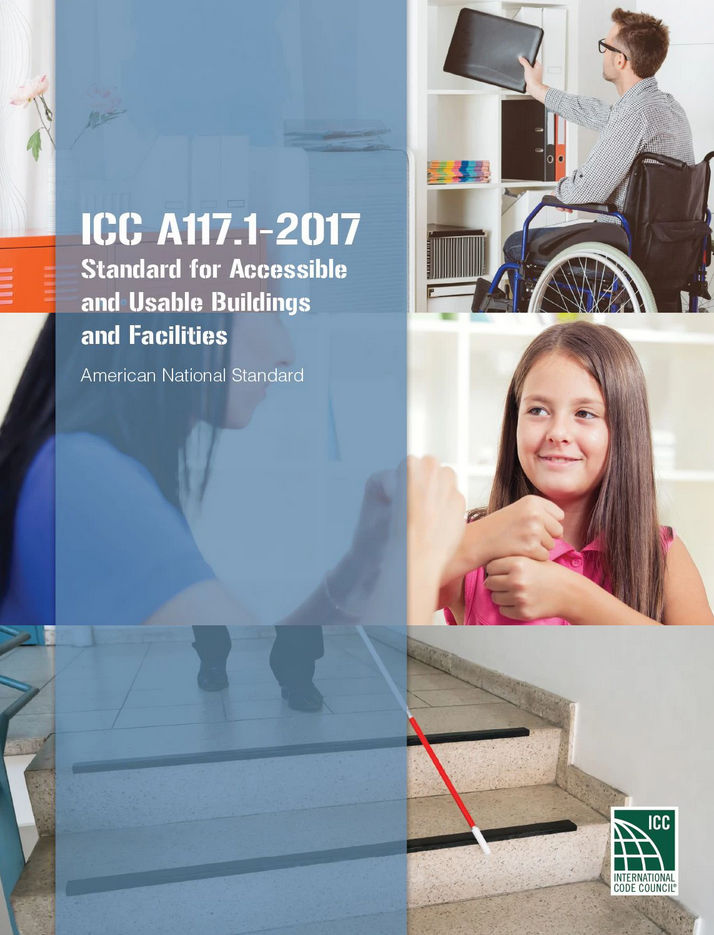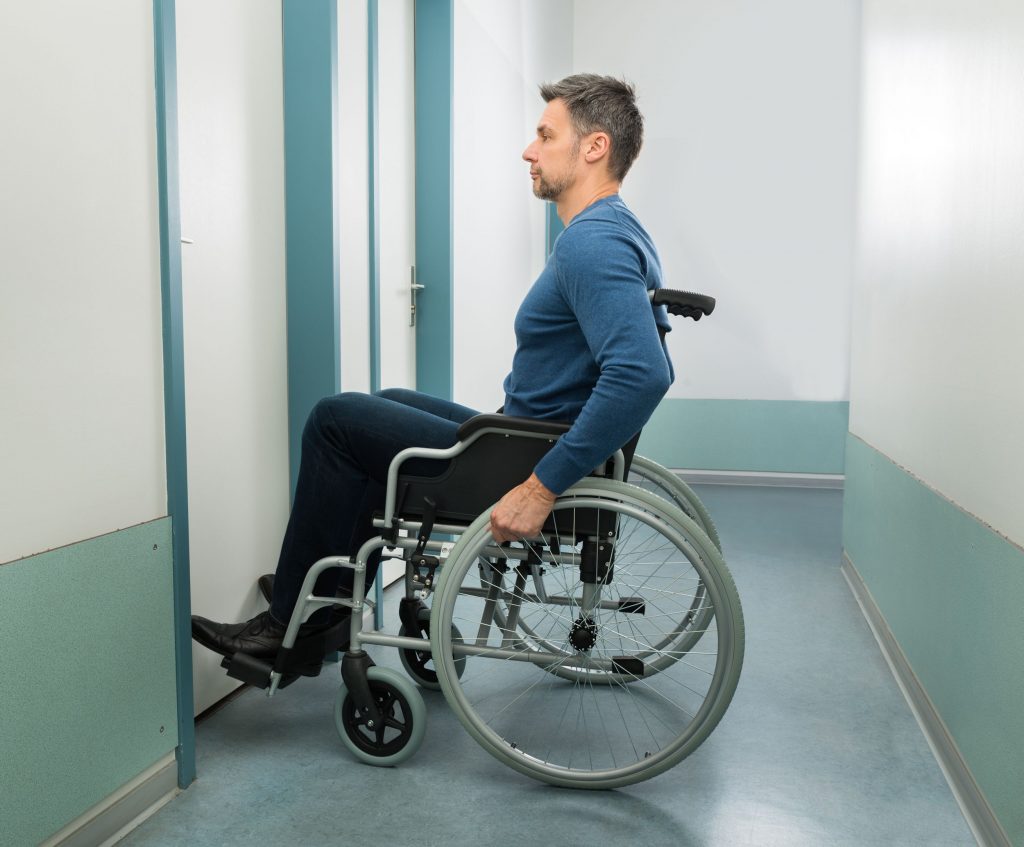 T
T here are two accessibility standards that are commonly used in the US for new and existing buildings, and the door-related requirements in these standards are almost identical. The two predominant accessibility standards are:
here are two accessibility standards that are commonly used in the US for new and existing buildings, and the door-related requirements in these standards are almost identical. The two predominant accessibility standards are:
- ICC A117.1 Accessible and Usable Buildings and Facilities – This standard is referenced by the International Building Code (IBC) for doors that are on an accessible route.
- ADA Standards for Accessible Design – This standard covers the requirements for compliance with the Americans With Disabilities Act (ADA), a federal law.
States may adopt one of these standards, or they may modify a standard or create their own. But because the ADA is a federal law, state accessibility requirements are typically similar to the ADA standards. There have been recent efforts to ensure that the requirements of ICC A117.1 and the ADA standards are consistent, but there are a few differences that affect door openings. For example:
- The ADA standards require hardware to be operable with 5 pounds of force or less, and the 2017 edition of ICC A117.1 requires hardware to be operable with 15 pounds of pushing/pulling motion or 28 inch-pounds of rotational motion (the 2021 edition of the IBC is consistent with the A117.1 requirements).
- The ADA standards require back-up power for doors equipped with automatic operators when the doors do not have the required maneuvering clearance for a manual door on the egress side. This was not required by the 2009 edition of ICC A117.1 or prior editions, but was added to the 2017 edition of this standard.
- The ADA standards include some exceptions that are specific to existing buildings, which are not included in ICC A117.1 because this standard is not usually applied retroactively to existing buildings.
For existing buildings, it can sometimes be difficult to determine which doors are required to meet the accessibility standards. Door openings in these facilities may need to be evaluated on a case-by-case basis. For new buildings that are required to comply with the IBC, the vast majority of door openings are required to be compliant with the accessibility standards. This paragraph explaining the scope of the accessibility requirements is found in the IBC Commentary for Chapter 11 – Accessibility:
 This section establishes the broad principle that all buildings, structures and their associated sites and facilities are required to be accessible to persons with disabilities. Such persons would include anyone who utilizes a space, including occupants, employees, students, spectators, participants and visitors. The approach taken by the code on the subject of accessibility is to require all construction to be accessible and then allow for the level of inaccessibility that is reasonable and logical. In codes created before the early 1990s, the approach was to list the conditions and occupancies to which the accessibility requirements applied. This is no longer practical, since the exceptions are far fewer than the circumstances to which accessibility applies. The 14 exceptions to this section, Sections 1103.2.1 to 1103.2.14 reflect the extent to which accessibility in construction is either exempted or reduced in scope.
This section establishes the broad principle that all buildings, structures and their associated sites and facilities are required to be accessible to persons with disabilities. Such persons would include anyone who utilizes a space, including occupants, employees, students, spectators, participants and visitors. The approach taken by the code on the subject of accessibility is to require all construction to be accessible and then allow for the level of inaccessibility that is reasonable and logical. In codes created before the early 1990s, the approach was to list the conditions and occupancies to which the accessibility requirements applied. This is no longer practical, since the exceptions are far fewer than the circumstances to which accessibility applies. The 14 exceptions to this section, Sections 1103.2.1 to 1103.2.14 reflect the extent to which accessibility in construction is either exempted or reduced in scope.
The 14 IBC exceptions, where some doors are exempt from the accessibility requirements, are:
- Employee work areas – only doors within the work area are exempt – doors used to enter or exit the work area are not
- Detached dwellings – 1- and 2-family residential dwellings
- Utility buildings – Group U with the exception of agricultural buildings open to the public and garages that contain required accessible parking
- Construction sites – including scaffolding, bridging, materials hoists, materials storage, and construction trailers
- Raised areas – platforms used for security, life safety, or fire safety
- Limited access spaces – accessed only by ladders, catwalks, crawl spaces, freight elevators or very narrow
passageways - Areas in places of religious worship – raised or lowered areas used for religious ceremonies, that are less than 300 square feet and located 7 inches or more above or below the finished floor
- Equipment spaces – used only by service personnel for maintenance, repair or occasional monitoring
of equipment - Highway tollbooths – where access is provided only by bridges above the vehicular traffic or underground tunnels
- Residential Group R-1 – which contain not more than five sleeping units for rent or hire that are also occupied as the residence of the proprietor
- Day care facilities – where the facility is part of a dwelling unit, only the day care facility is required to comply with ICC A117.1
- Detention and correctional – common use areas that are used only by inmates or detainees and security personnel, and that do not serve holding cells or housing cells required to be Accessible units
- Walk-in coolers and freezers – intended for employee use only
- Specific requirements – where Chapter 11 of the IBC exempts areas from specific accessibility requirements
Refer to the IBC for more information about these exemptions. The 2010 ADA Standards also include some exceptions where doors are not required to comply.
The video below offers a brief overview of the accessibility requirements that apply to door openings. Each of these requirements will be addressed in more detail in future ShortCodes segments. Note: The video mentions that automatic operators are not specifically required by the accessibility standards, however, the 2021 edition of the IBC does require automatic doors on some public entrances (more info here).
After watching the video, proceed to the review questions below. For reference, the US Access Board has created an online Guide to the ADA Accessibility Standards, and the International Code Council has published a Commentary edition of ICC A117.1 which includes supplemental information to help explain the requirements of the standard.
Photo: Andrey Popov/shutterstock.com
~~~
Review Questions
1. Which accessibility standard is referenced by the International Building Code?
- ADA Standards for Accessible Design
- ICC A117.1 Accessible and Usable Buildings and Facilities
- Uniform Federal Accessibility Standard
- None of the above
2. Which accessibility standard covers the requirements for compliance with a federal law?
- ADA Standards for Accessible Design
- ICC A117.1 Accessible and Usable Buildings and Facilities
- Uniform Federal Accessibility Standards
- None of the above
3. According to the International Building Code, which door openings must meet the accessibility requirements?
- Doors that are identified with an accessibility symbol
- Main entrance doors and bathroom doors
- All doors for user passage, except in locations covered by the 14 IBC exceptions
- Doors that lead from occupied areas to one accessible route through the building
Answers: 1 – B, 2 – A, 3 – C
